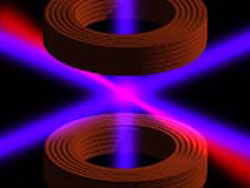Experimental atomic clock uses ytterbium ’pancakes’

NIST’s new optical atomic clock uses two magnetic coils (red rings) and an optical lattice (red laser beam), as well as intersecting violet lasers to cool ytterbium atoms, slowing their motion. Illustration credit: NIST
Scientists at the National Institute of Standards and Technology (NIST) working with Russian colleagues have significantly improved the design of optical atomic clocks that hold thousands of atoms in a lattice made of intersecting laser beams. The design, in which ytterbium atoms oscillate or “tick” at optical frequencies, has the potential to be more stable and accurate than today’s best time standards, which are based on microwaves at much lower frequencies. More accurate time standards could improve communications, enhance navigation systems, and enable new tests of physical theories, among other applications.
Described in two papers in the March 3 issue of Physical Review Letters,* the heart of the clock consists of about 1,000 pancake-shaped wells made of laser light and arranged in a single line, each containing about 10 atoms of the heavy metal ytterbium. The lattice design results in fewer systematic errors than optical atomic clocks using moving balls of cold atoms, and also offers advantages in parallel processing over other approaches using single charged atoms (ions). The optical lattice, created by an intense near-visible laser beam, is loaded by first slowing down the atoms with violet laser light and then using green laser light to further cool the atoms so that they can be captured. Scientists detect the atoms’ “ticks” (518 quadrillion per second) by bathing them in yellow light at slightly different frequencies until they find the exact “resonant” frequency (or color) that the atoms absorb best.
Previous lattice-based clocks have used atoms with odd-numbered atomic masses, which have a nuclear magnetic field that causes some additional complications. The new clock uses atoms with even-numbered atomic masses that have no net nuclear magnetic field but have been difficult to use in atomic clocks until now. The researchers found they could apply a small external magnetic field combined with yellow laser light to induce an otherwise “forbidden” oscillation between two energy levels in the atoms. The team reported an extremely precise resonance frequency with a strong signal that demonstrates the clock’s potential for very high stability. The new approach is also applicable to other atoms with even-numbered atomic masses, such as strontium and calcium, which are under study at NIST and other research laboratories around the world.
Media Contact
More Information:
http://www.nist.govAll latest news from the category: Physics and Astronomy
This area deals with the fundamental laws and building blocks of nature and how they interact, the properties and the behavior of matter, and research into space and time and their structures.
innovations-report provides in-depth reports and articles on subjects such as astrophysics, laser technologies, nuclear, quantum, particle and solid-state physics, nanotechnologies, planetary research and findings (Mars, Venus) and developments related to the Hubble Telescope.
Newest articles

Recovering phosphorus from sewage sludge ash
Chemical and heat treatment of sewage sludge can recover phosphorus in a process that could help address the problem of diminishing supplies of phosphorus ores. Valuable supplies of phosphorus could…

Efficient, sustainable and cost-effective hybrid energy storage system for modern power grids
EU project HyFlow: Over three years of research, the consortium of the EU project HyFlow has successfully developed a highly efficient, sustainable, and cost-effective hybrid energy storage system (HESS) that…

After 25 years, researchers uncover genetic cause of rare neurological disease
Some families call it a trial of faith. Others just call it a curse. The progressive neurological disease known as spinocerebellar ataxia 4 (SCA4) is a rare condition, but its…





















